Leadership in Public Health: A Comprehensive Literature Review
VerifiedAdded on 2022/11/23
|14
|3927
|286
Literature Review
AI Summary
This literature review examines the critical role of effective leadership within public health organizations, particularly those addressing kidney disease. It explores various leadership styles, including transactional, transformational, servant, and authentic leadership, and their impact on organizational effectiveness. The review identifies theoretical gaps in the existing literature, highlighting the need for leaders to adapt to the rapidly changing healthcare landscape, manage resources efficiently, and foster cross-disciplinary collaboration. The problem statement focuses on the necessity of effective leadership in public health organizations dealing with kidney disease, addressing the identified theoretical gaps by emphasizing the importance of emotional intelligence, integrity, and a clear vision. The review also touches on the social change implications of effective leadership, underscoring the need for sustainable solutions and collaboration with various stakeholders to improve public health outcomes. Desklib provides access to this and other solved assignments to support student learning.
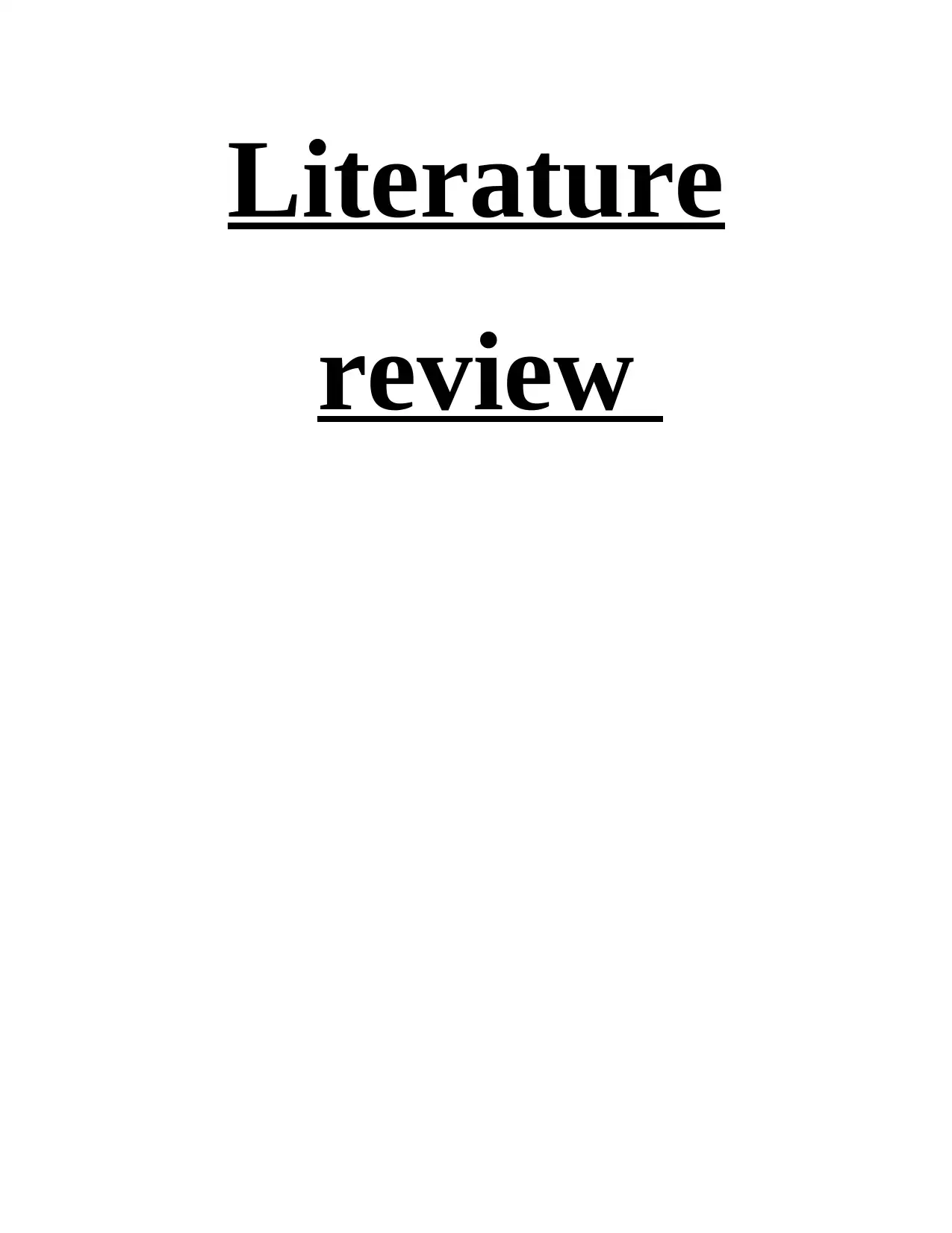
Literature
review
review
Paraphrase This Document
Need a fresh take? Get an instant paraphrase of this document with our AI Paraphraser
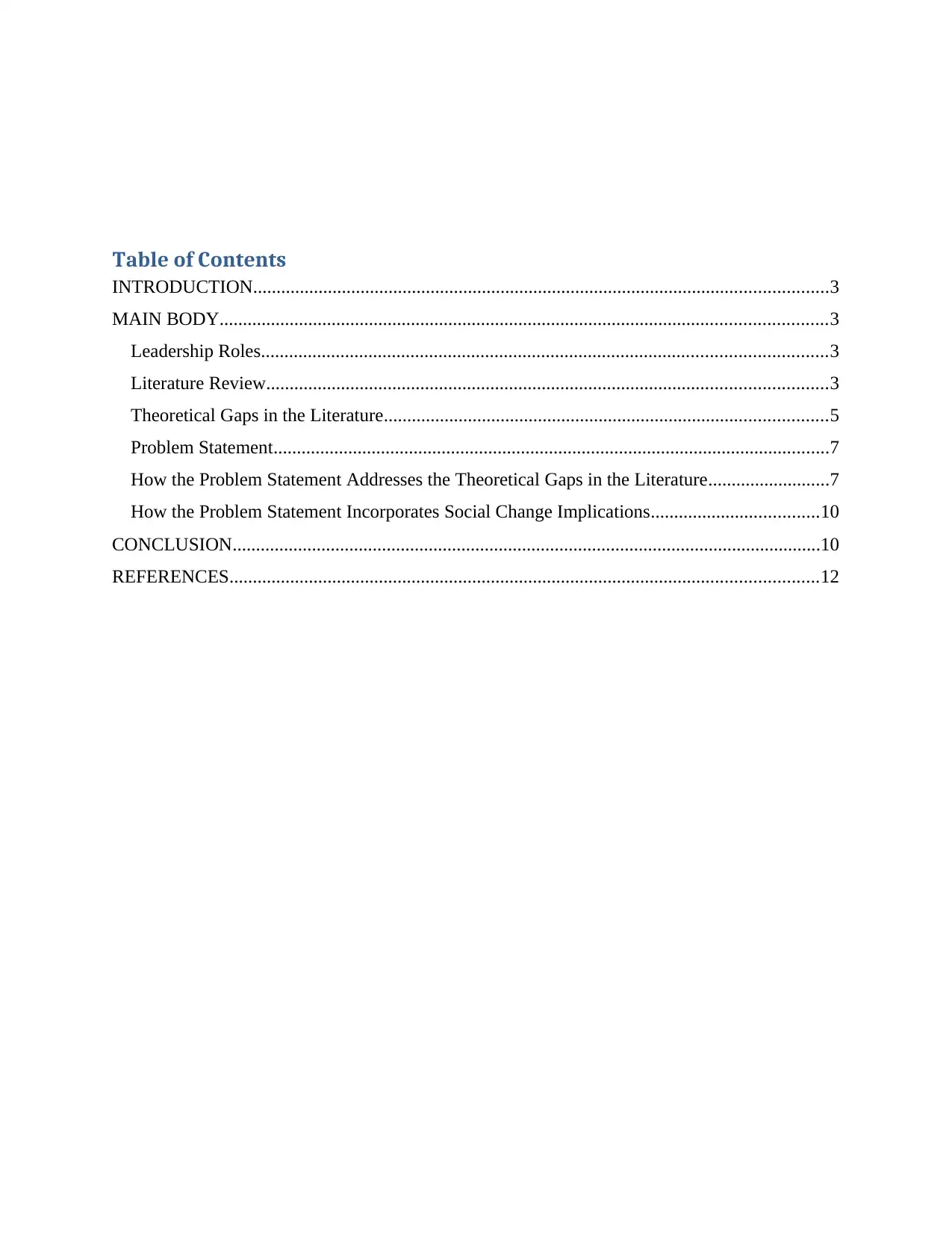
Table of Contents
INTRODUCTION...........................................................................................................................3
MAIN BODY..................................................................................................................................3
Leadership Roles.........................................................................................................................3
Literature Review........................................................................................................................3
Theoretical Gaps in the Literature...............................................................................................5
Problem Statement.......................................................................................................................7
How the Problem Statement Addresses the Theoretical Gaps in the Literature..........................7
How the Problem Statement Incorporates Social Change Implications....................................10
CONCLUSION..............................................................................................................................10
REFERENCES..............................................................................................................................12
INTRODUCTION...........................................................................................................................3
MAIN BODY..................................................................................................................................3
Leadership Roles.........................................................................................................................3
Literature Review........................................................................................................................3
Theoretical Gaps in the Literature...............................................................................................5
Problem Statement.......................................................................................................................7
How the Problem Statement Addresses the Theoretical Gaps in the Literature..........................7
How the Problem Statement Incorporates Social Change Implications....................................10
CONCLUSION..............................................................................................................................10
REFERENCES..............................................................................................................................12
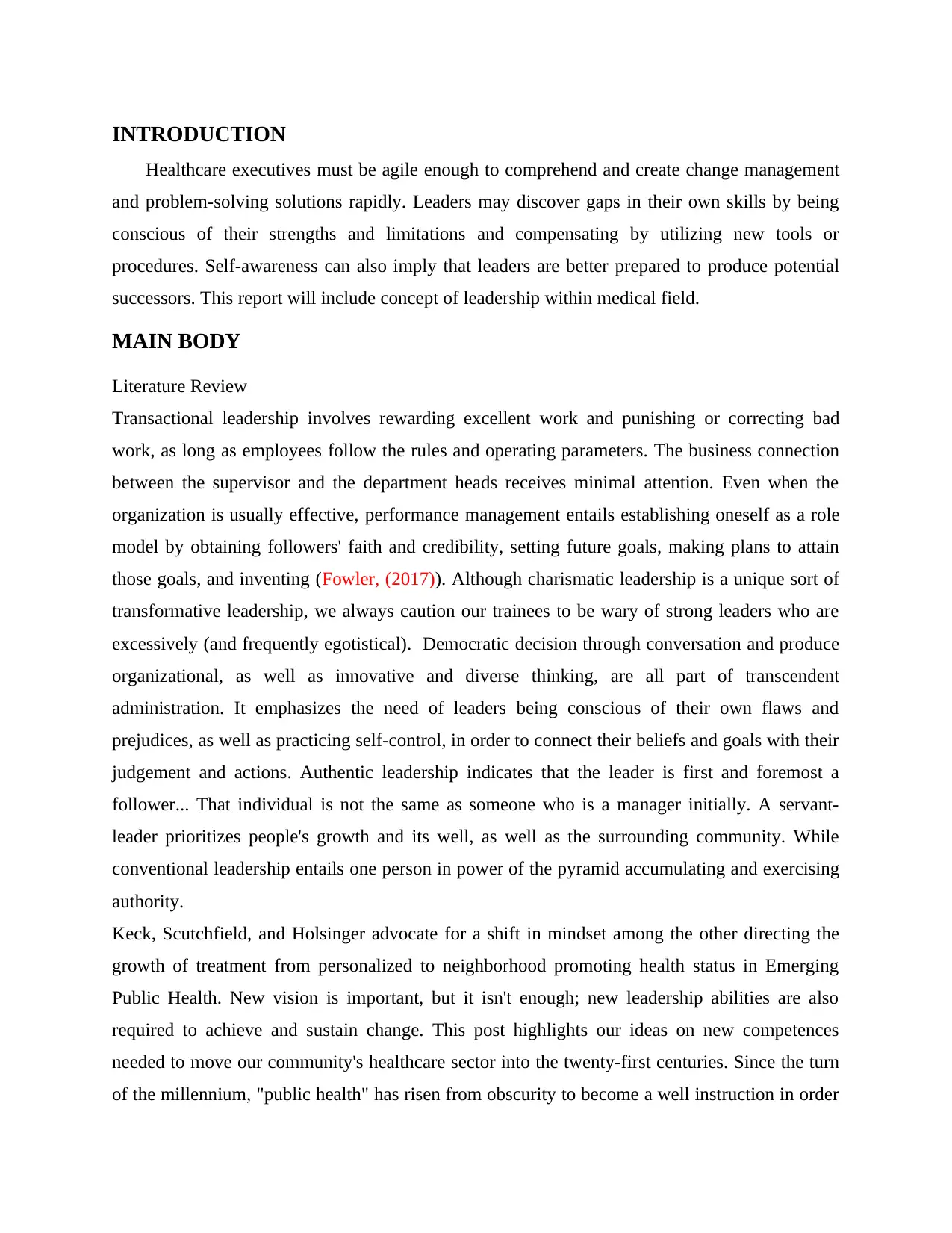
INTRODUCTION
Healthcare executives must be agile enough to comprehend and create change management
and problem-solving solutions rapidly. Leaders may discover gaps in their own skills by being
conscious of their strengths and limitations and compensating by utilizing new tools or
procedures. Self-awareness can also imply that leaders are better prepared to produce potential
successors. This report will include concept of leadership within medical field.
MAIN BODY
Literature Review
Transactional leadership involves rewarding excellent work and punishing or correcting bad
work, as long as employees follow the rules and operating parameters. The business connection
between the supervisor and the department heads receives minimal attention. Even when the
organization is usually effective, performance management entails establishing oneself as a role
model by obtaining followers' faith and credibility, setting future goals, making plans to attain
those goals, and inventing (Fowler, (2017)). Although charismatic leadership is a unique sort of
transformative leadership, we always caution our trainees to be wary of strong leaders who are
excessively (and frequently egotistical). Democratic decision through conversation and produce
organizational, as well as innovative and diverse thinking, are all part of transcendent
administration. It emphasizes the need of leaders being conscious of their own flaws and
prejudices, as well as practicing self-control, in order to connect their beliefs and goals with their
judgement and actions. Authentic leadership indicates that the leader is first and foremost a
follower... That individual is not the same as someone who is a manager initially. A servant-
leader prioritizes people's growth and its well, as well as the surrounding community. While
conventional leadership entails one person in power of the pyramid accumulating and exercising
authority.
Keck, Scutchfield, and Holsinger advocate for a shift in mindset among the other directing the
growth of treatment from personalized to neighborhood promoting health status in Emerging
Public Health. New vision is important, but it isn't enough; new leadership abilities are also
required to achieve and sustain change. This post highlights our ideas on new competences
needed to move our community's healthcare sector into the twenty-first centuries. Since the turn
of the millennium, "public health" has risen from obscurity to become a well instruction in order
Healthcare executives must be agile enough to comprehend and create change management
and problem-solving solutions rapidly. Leaders may discover gaps in their own skills by being
conscious of their strengths and limitations and compensating by utilizing new tools or
procedures. Self-awareness can also imply that leaders are better prepared to produce potential
successors. This report will include concept of leadership within medical field.
MAIN BODY
Literature Review
Transactional leadership involves rewarding excellent work and punishing or correcting bad
work, as long as employees follow the rules and operating parameters. The business connection
between the supervisor and the department heads receives minimal attention. Even when the
organization is usually effective, performance management entails establishing oneself as a role
model by obtaining followers' faith and credibility, setting future goals, making plans to attain
those goals, and inventing (Fowler, (2017)). Although charismatic leadership is a unique sort of
transformative leadership, we always caution our trainees to be wary of strong leaders who are
excessively (and frequently egotistical). Democratic decision through conversation and produce
organizational, as well as innovative and diverse thinking, are all part of transcendent
administration. It emphasizes the need of leaders being conscious of their own flaws and
prejudices, as well as practicing self-control, in order to connect their beliefs and goals with their
judgement and actions. Authentic leadership indicates that the leader is first and foremost a
follower... That individual is not the same as someone who is a manager initially. A servant-
leader prioritizes people's growth and its well, as well as the surrounding community. While
conventional leadership entails one person in power of the pyramid accumulating and exercising
authority.
Keck, Scutchfield, and Holsinger advocate for a shift in mindset among the other directing the
growth of treatment from personalized to neighborhood promoting health status in Emerging
Public Health. New vision is important, but it isn't enough; new leadership abilities are also
required to achieve and sustain change. This post highlights our ideas on new competences
needed to move our community's healthcare sector into the twenty-first centuries. Since the turn
of the millennium, "public health" has risen from obscurity to become a well instruction in order
⊘ This is a preview!⊘
Do you want full access?
Subscribe today to unlock all pages.

Trusted by 1+ million students worldwide
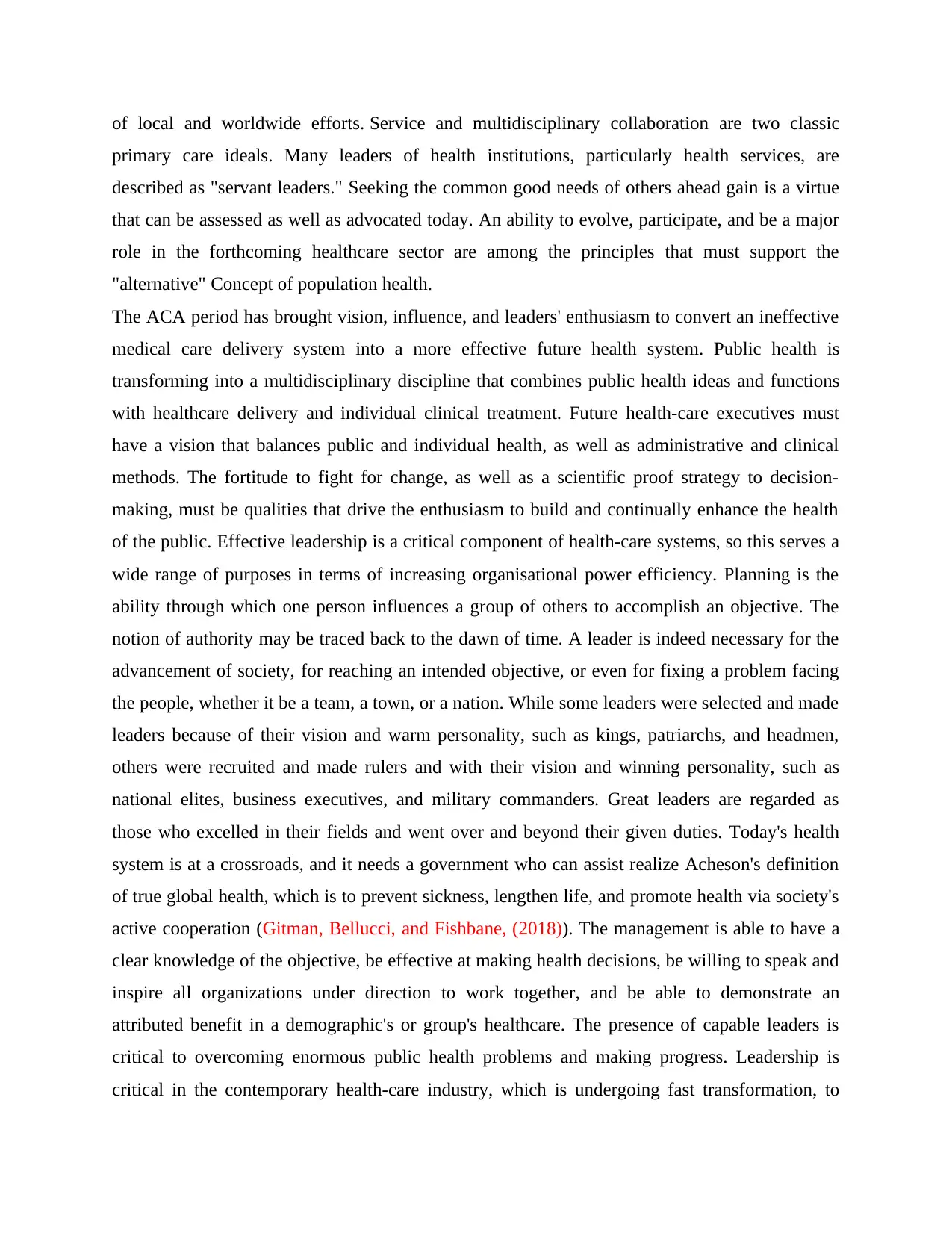
of local and worldwide efforts. Service and multidisciplinary collaboration are two classic
primary care ideals. Many leaders of health institutions, particularly health services, are
described as "servant leaders." Seeking the common good needs of others ahead gain is a virtue
that can be assessed as well as advocated today. An ability to evolve, participate, and be a major
role in the forthcoming healthcare sector are among the principles that must support the
"alternative" Concept of population health.
The ACA period has brought vision, influence, and leaders' enthusiasm to convert an ineffective
medical care delivery system into a more effective future health system. Public health is
transforming into a multidisciplinary discipline that combines public health ideas and functions
with healthcare delivery and individual clinical treatment. Future health-care executives must
have a vision that balances public and individual health, as well as administrative and clinical
methods. The fortitude to fight for change, as well as a scientific proof strategy to decision-
making, must be qualities that drive the enthusiasm to build and continually enhance the health
of the public. Effective leadership is a critical component of health-care systems, so this serves a
wide range of purposes in terms of increasing organisational power efficiency. Planning is the
ability through which one person influences a group of others to accomplish an objective. The
notion of authority may be traced back to the dawn of time. A leader is indeed necessary for the
advancement of society, for reaching an intended objective, or even for fixing a problem facing
the people, whether it be a team, a town, or a nation. While some leaders were selected and made
leaders because of their vision and warm personality, such as kings, patriarchs, and headmen,
others were recruited and made rulers and with their vision and winning personality, such as
national elites, business executives, and military commanders. Great leaders are regarded as
those who excelled in their fields and went over and beyond their given duties. Today's health
system is at a crossroads, and it needs a government who can assist realize Acheson's definition
of true global health, which is to prevent sickness, lengthen life, and promote health via society's
active cooperation (Gitman, Bellucci, and Fishbane, (2018)). The management is able to have a
clear knowledge of the objective, be effective at making health decisions, be willing to speak and
inspire all organizations under direction to work together, and be able to demonstrate an
attributed benefit in a demographic's or group's healthcare. The presence of capable leaders is
critical to overcoming enormous public health problems and making progress. Leadership is
critical in the contemporary health-care industry, which is undergoing fast transformation, to
primary care ideals. Many leaders of health institutions, particularly health services, are
described as "servant leaders." Seeking the common good needs of others ahead gain is a virtue
that can be assessed as well as advocated today. An ability to evolve, participate, and be a major
role in the forthcoming healthcare sector are among the principles that must support the
"alternative" Concept of population health.
The ACA period has brought vision, influence, and leaders' enthusiasm to convert an ineffective
medical care delivery system into a more effective future health system. Public health is
transforming into a multidisciplinary discipline that combines public health ideas and functions
with healthcare delivery and individual clinical treatment. Future health-care executives must
have a vision that balances public and individual health, as well as administrative and clinical
methods. The fortitude to fight for change, as well as a scientific proof strategy to decision-
making, must be qualities that drive the enthusiasm to build and continually enhance the health
of the public. Effective leadership is a critical component of health-care systems, so this serves a
wide range of purposes in terms of increasing organisational power efficiency. Planning is the
ability through which one person influences a group of others to accomplish an objective. The
notion of authority may be traced back to the dawn of time. A leader is indeed necessary for the
advancement of society, for reaching an intended objective, or even for fixing a problem facing
the people, whether it be a team, a town, or a nation. While some leaders were selected and made
leaders because of their vision and warm personality, such as kings, patriarchs, and headmen,
others were recruited and made rulers and with their vision and winning personality, such as
national elites, business executives, and military commanders. Great leaders are regarded as
those who excelled in their fields and went over and beyond their given duties. Today's health
system is at a crossroads, and it needs a government who can assist realize Acheson's definition
of true global health, which is to prevent sickness, lengthen life, and promote health via society's
active cooperation (Gitman, Bellucci, and Fishbane, (2018)). The management is able to have a
clear knowledge of the objective, be effective at making health decisions, be willing to speak and
inspire all organizations under direction to work together, and be able to demonstrate an
attributed benefit in a demographic's or group's healthcare. The presence of capable leaders is
critical to overcoming enormous public health problems and making progress. Leadership is
critical in the contemporary health-care industry, which is undergoing fast transformation, to
Paraphrase This Document
Need a fresh take? Get an instant paraphrase of this document with our AI Paraphraser
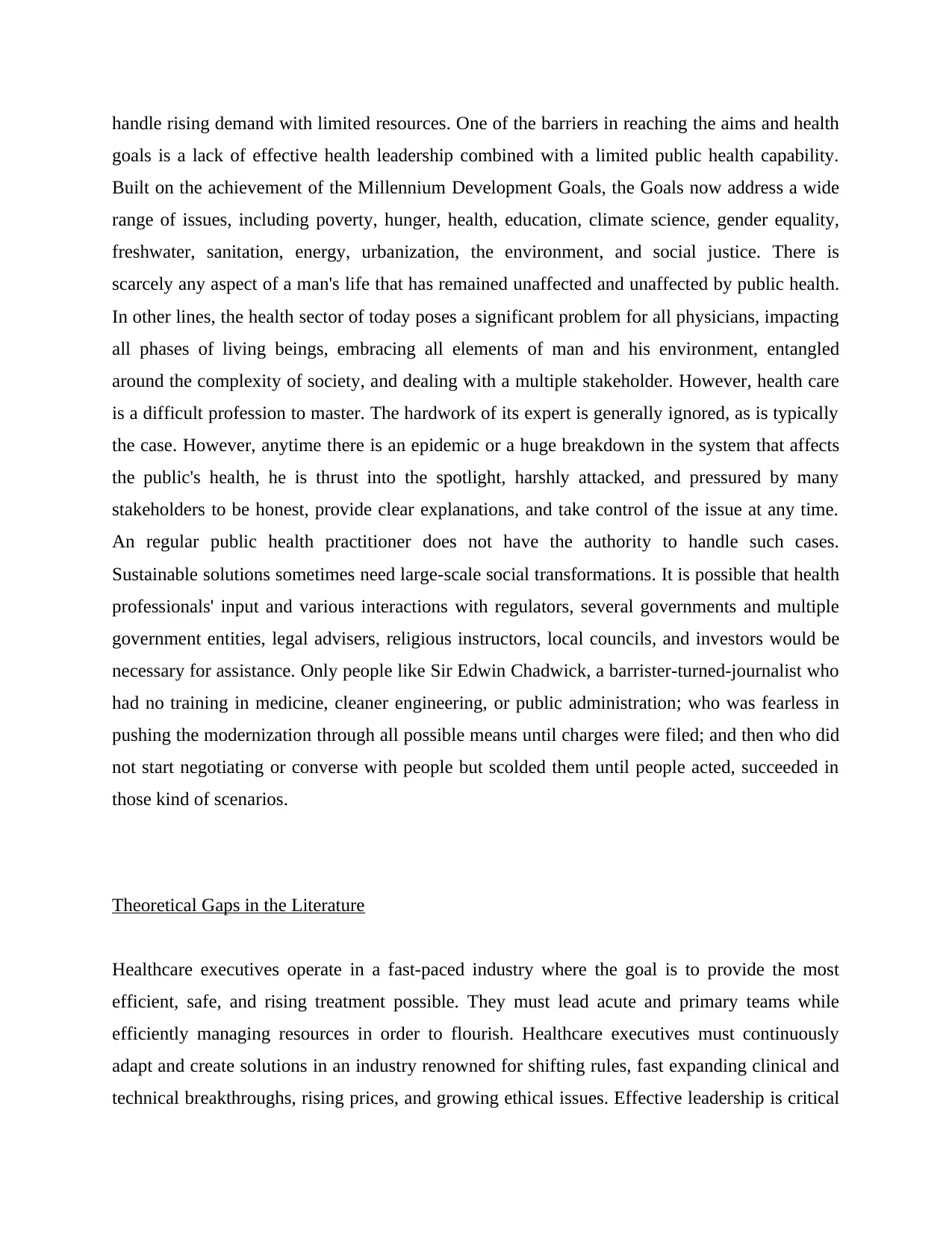
handle rising demand with limited resources. One of the barriers in reaching the aims and health
goals is a lack of effective health leadership combined with a limited public health capability.
Built on the achievement of the Millennium Development Goals, the Goals now address a wide
range of issues, including poverty, hunger, health, education, climate science, gender equality,
freshwater, sanitation, energy, urbanization, the environment, and social justice. There is
scarcely any aspect of a man's life that has remained unaffected and unaffected by public health.
In other lines, the health sector of today poses a significant problem for all physicians, impacting
all phases of living beings, embracing all elements of man and his environment, entangled
around the complexity of society, and dealing with a multiple stakeholder. However, health care
is a difficult profession to master. The hardwork of its expert is generally ignored, as is typically
the case. However, anytime there is an epidemic or a huge breakdown in the system that affects
the public's health, he is thrust into the spotlight, harshly attacked, and pressured by many
stakeholders to be honest, provide clear explanations, and take control of the issue at any time.
An regular public health practitioner does not have the authority to handle such cases.
Sustainable solutions sometimes need large-scale social transformations. It is possible that health
professionals' input and various interactions with regulators, several governments and multiple
government entities, legal advisers, religious instructors, local councils, and investors would be
necessary for assistance. Only people like Sir Edwin Chadwick, a barrister-turned-journalist who
had no training in medicine, cleaner engineering, or public administration; who was fearless in
pushing the modernization through all possible means until charges were filed; and then who did
not start negotiating or converse with people but scolded them until people acted, succeeded in
those kind of scenarios.
Theoretical Gaps in the Literature
Healthcare executives operate in a fast-paced industry where the goal is to provide the most
efficient, safe, and rising treatment possible. They must lead acute and primary teams while
efficiently managing resources in order to flourish. Healthcare executives must continuously
adapt and create solutions in an industry renowned for shifting rules, fast expanding clinical and
technical breakthroughs, rising prices, and growing ethical issues. Effective leadership is critical
goals is a lack of effective health leadership combined with a limited public health capability.
Built on the achievement of the Millennium Development Goals, the Goals now address a wide
range of issues, including poverty, hunger, health, education, climate science, gender equality,
freshwater, sanitation, energy, urbanization, the environment, and social justice. There is
scarcely any aspect of a man's life that has remained unaffected and unaffected by public health.
In other lines, the health sector of today poses a significant problem for all physicians, impacting
all phases of living beings, embracing all elements of man and his environment, entangled
around the complexity of society, and dealing with a multiple stakeholder. However, health care
is a difficult profession to master. The hardwork of its expert is generally ignored, as is typically
the case. However, anytime there is an epidemic or a huge breakdown in the system that affects
the public's health, he is thrust into the spotlight, harshly attacked, and pressured by many
stakeholders to be honest, provide clear explanations, and take control of the issue at any time.
An regular public health practitioner does not have the authority to handle such cases.
Sustainable solutions sometimes need large-scale social transformations. It is possible that health
professionals' input and various interactions with regulators, several governments and multiple
government entities, legal advisers, religious instructors, local councils, and investors would be
necessary for assistance. Only people like Sir Edwin Chadwick, a barrister-turned-journalist who
had no training in medicine, cleaner engineering, or public administration; who was fearless in
pushing the modernization through all possible means until charges were filed; and then who did
not start negotiating or converse with people but scolded them until people acted, succeeded in
those kind of scenarios.
Theoretical Gaps in the Literature
Healthcare executives operate in a fast-paced industry where the goal is to provide the most
efficient, safe, and rising treatment possible. They must lead acute and primary teams while
efficiently managing resources in order to flourish. Healthcare executives must continuously
adapt and create solutions in an industry renowned for shifting rules, fast expanding clinical and
technical breakthroughs, rising prices, and growing ethical issues. Effective leadership is critical
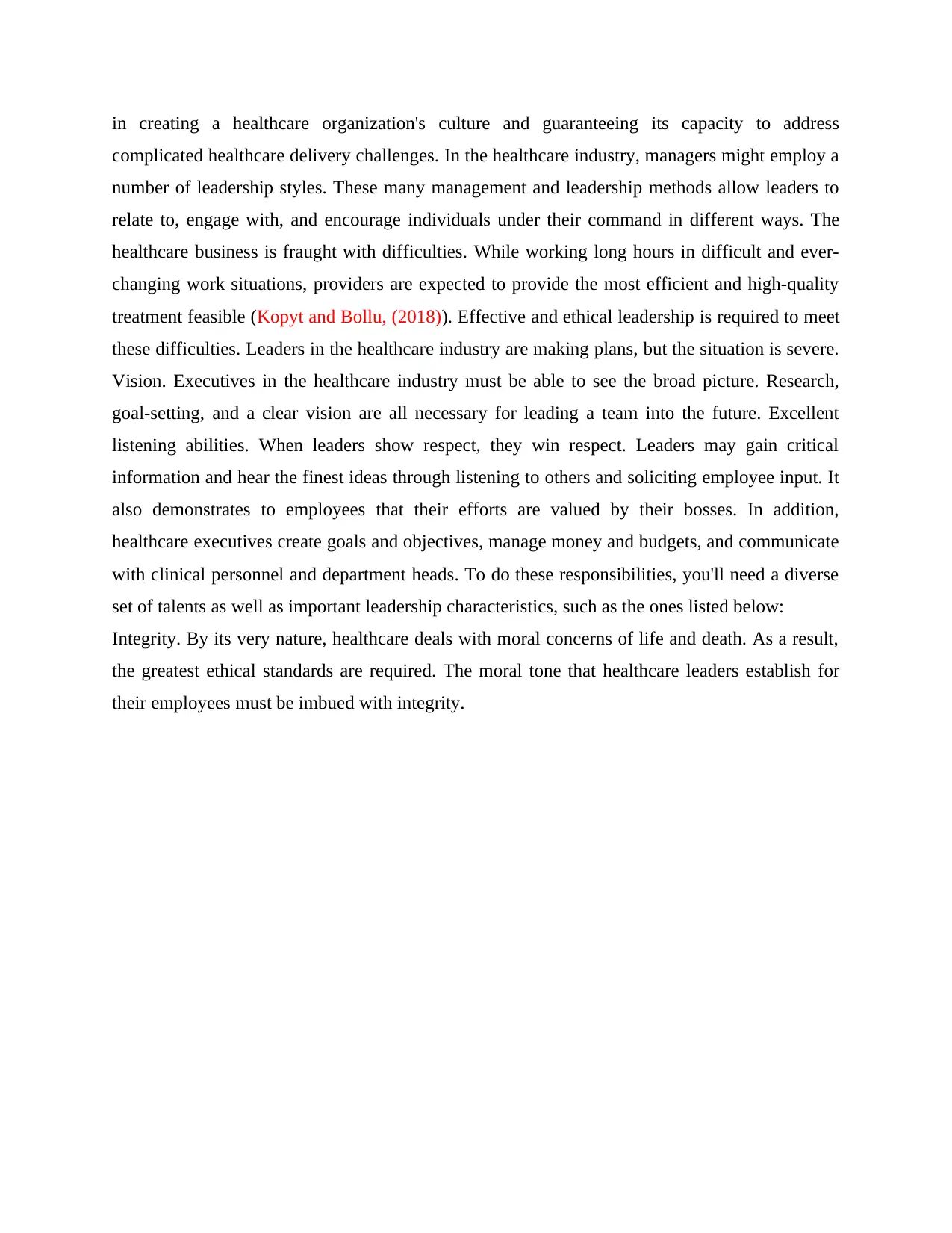
in creating a healthcare organization's culture and guaranteeing its capacity to address
complicated healthcare delivery challenges. In the healthcare industry, managers might employ a
number of leadership styles. These many management and leadership methods allow leaders to
relate to, engage with, and encourage individuals under their command in different ways. The
healthcare business is fraught with difficulties. While working long hours in difficult and ever-
changing work situations, providers are expected to provide the most efficient and high-quality
treatment feasible (Kopyt and Bollu, (2018)). Effective and ethical leadership is required to meet
these difficulties. Leaders in the healthcare industry are making plans, but the situation is severe.
Vision. Executives in the healthcare industry must be able to see the broad picture. Research,
goal-setting, and a clear vision are all necessary for leading a team into the future. Excellent
listening abilities. When leaders show respect, they win respect. Leaders may gain critical
information and hear the finest ideas through listening to others and soliciting employee input. It
also demonstrates to employees that their efforts are valued by their bosses. In addition,
healthcare executives create goals and objectives, manage money and budgets, and communicate
with clinical personnel and department heads. To do these responsibilities, you'll need a diverse
set of talents as well as important leadership characteristics, such as the ones listed below:
Integrity. By its very nature, healthcare deals with moral concerns of life and death. As a result,
the greatest ethical standards are required. The moral tone that healthcare leaders establish for
their employees must be imbued with integrity.
complicated healthcare delivery challenges. In the healthcare industry, managers might employ a
number of leadership styles. These many management and leadership methods allow leaders to
relate to, engage with, and encourage individuals under their command in different ways. The
healthcare business is fraught with difficulties. While working long hours in difficult and ever-
changing work situations, providers are expected to provide the most efficient and high-quality
treatment feasible (Kopyt and Bollu, (2018)). Effective and ethical leadership is required to meet
these difficulties. Leaders in the healthcare industry are making plans, but the situation is severe.
Vision. Executives in the healthcare industry must be able to see the broad picture. Research,
goal-setting, and a clear vision are all necessary for leading a team into the future. Excellent
listening abilities. When leaders show respect, they win respect. Leaders may gain critical
information and hear the finest ideas through listening to others and soliciting employee input. It
also demonstrates to employees that their efforts are valued by their bosses. In addition,
healthcare executives create goals and objectives, manage money and budgets, and communicate
with clinical personnel and department heads. To do these responsibilities, you'll need a diverse
set of talents as well as important leadership characteristics, such as the ones listed below:
Integrity. By its very nature, healthcare deals with moral concerns of life and death. As a result,
the greatest ethical standards are required. The moral tone that healthcare leaders establish for
their employees must be imbued with integrity.
⊘ This is a preview!⊘
Do you want full access?
Subscribe today to unlock all pages.

Trusted by 1+ million students worldwide
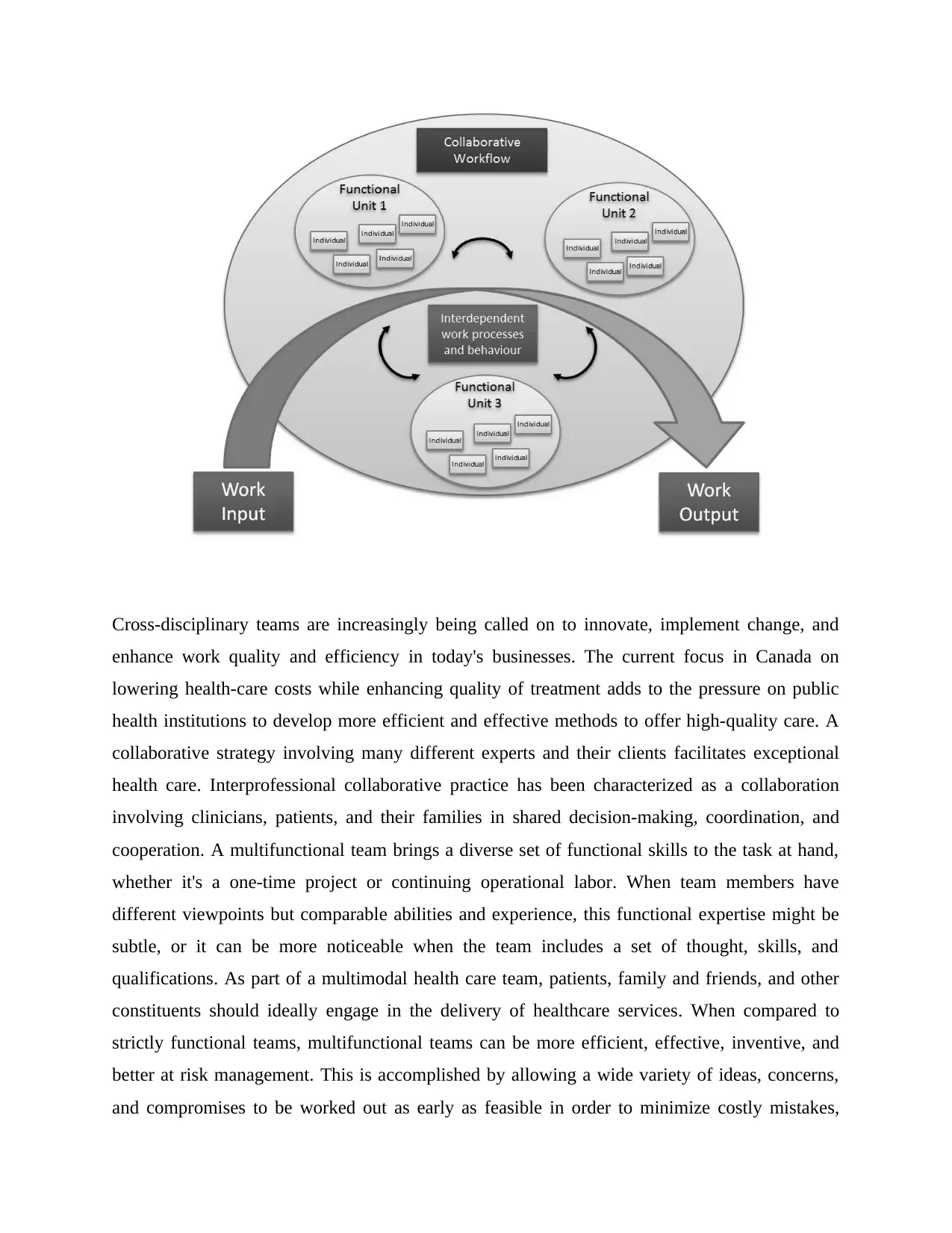
Cross-disciplinary teams are increasingly being called on to innovate, implement change, and
enhance work quality and efficiency in today's businesses. The current focus in Canada on
lowering health-care costs while enhancing quality of treatment adds to the pressure on public
health institutions to develop more efficient and effective methods to offer high-quality care. A
collaborative strategy involving many different experts and their clients facilitates exceptional
health care. Interprofessional collaborative practice has been characterized as a collaboration
involving clinicians, patients, and their families in shared decision-making, coordination, and
cooperation. A multifunctional team brings a diverse set of functional skills to the task at hand,
whether it's a one-time project or continuing operational labor. When team members have
different viewpoints but comparable abilities and experience, this functional expertise might be
subtle, or it can be more noticeable when the team includes a set of thought, skills, and
qualifications. As part of a multimodal health care team, patients, family and friends, and other
constituents should ideally engage in the delivery of healthcare services. When compared to
strictly functional teams, multifunctional teams can be more efficient, effective, inventive, and
better at risk management. This is accomplished by allowing a wide variety of ideas, concerns,
and compromises to be worked out as early as feasible in order to minimize costly mistakes,
enhance work quality and efficiency in today's businesses. The current focus in Canada on
lowering health-care costs while enhancing quality of treatment adds to the pressure on public
health institutions to develop more efficient and effective methods to offer high-quality care. A
collaborative strategy involving many different experts and their clients facilitates exceptional
health care. Interprofessional collaborative practice has been characterized as a collaboration
involving clinicians, patients, and their families in shared decision-making, coordination, and
cooperation. A multifunctional team brings a diverse set of functional skills to the task at hand,
whether it's a one-time project or continuing operational labor. When team members have
different viewpoints but comparable abilities and experience, this functional expertise might be
subtle, or it can be more noticeable when the team includes a set of thought, skills, and
qualifications. As part of a multimodal health care team, patients, family and friends, and other
constituents should ideally engage in the delivery of healthcare services. When compared to
strictly functional teams, multifunctional teams can be more efficient, effective, inventive, and
better at risk management. This is accomplished by allowing a wide variety of ideas, concerns,
and compromises to be worked out as early as feasible in order to minimize costly mistakes,
Paraphrase This Document
Need a fresh take? Get an instant paraphrase of this document with our AI Paraphraser
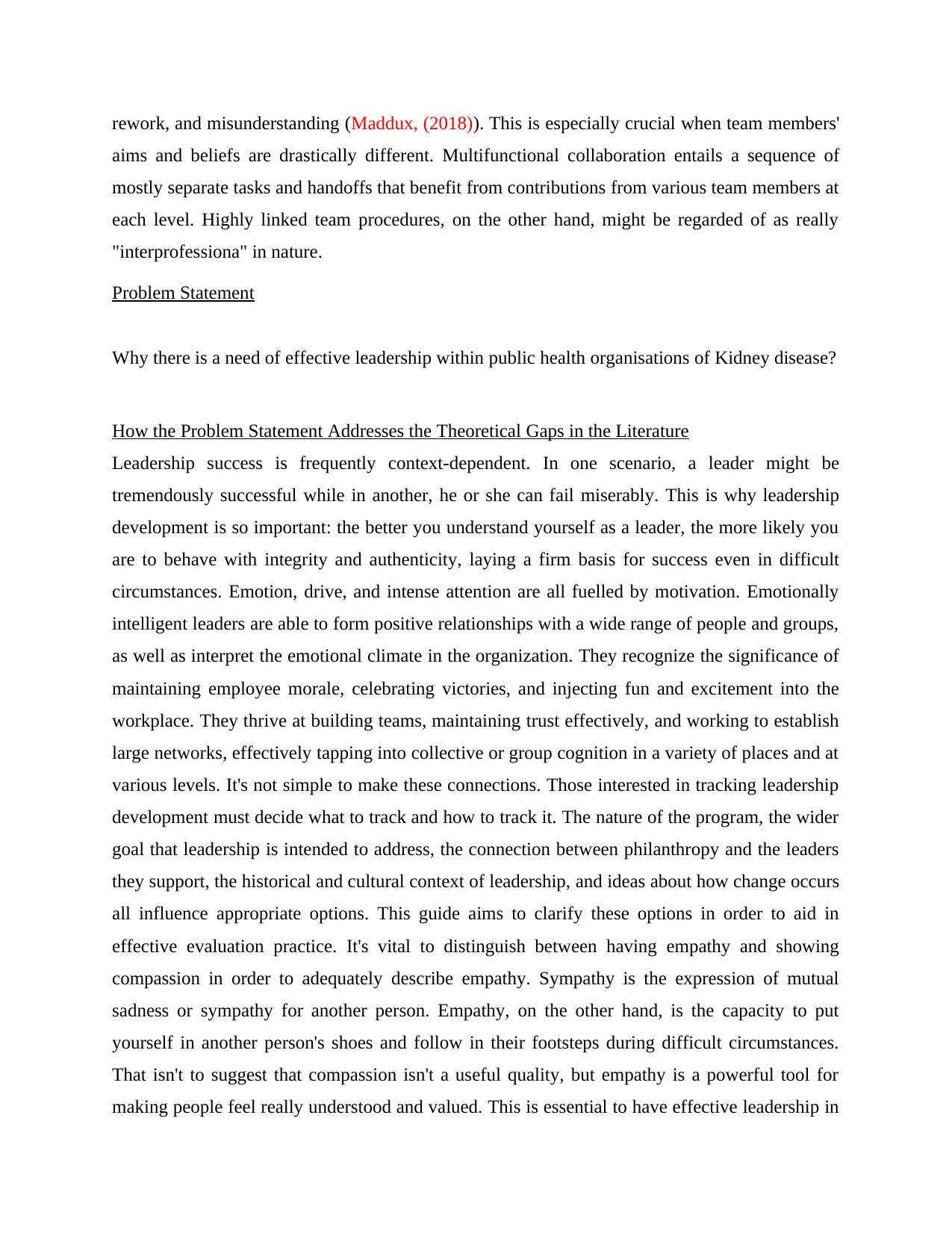
rework, and misunderstanding (Maddux, (2018)). This is especially crucial when team members'
aims and beliefs are drastically different. Multifunctional collaboration entails a sequence of
mostly separate tasks and handoffs that benefit from contributions from various team members at
each level. Highly linked team procedures, on the other hand, might be regarded of as really
"interprofessiona" in nature.
Problem Statement
Why there is a need of effective leadership within public health organisations of Kidney disease?
How the Problem Statement Addresses the Theoretical Gaps in the Literature
Leadership success is frequently context-dependent. In one scenario, a leader might be
tremendously successful while in another, he or she can fail miserably. This is why leadership
development is so important: the better you understand yourself as a leader, the more likely you
are to behave with integrity and authenticity, laying a firm basis for success even in difficult
circumstances. Emotion, drive, and intense attention are all fuelled by motivation. Emotionally
intelligent leaders are able to form positive relationships with a wide range of people and groups,
as well as interpret the emotional climate in the organization. They recognize the significance of
maintaining employee morale, celebrating victories, and injecting fun and excitement into the
workplace. They thrive at building teams, maintaining trust effectively, and working to establish
large networks, effectively tapping into collective or group cognition in a variety of places and at
various levels. It's not simple to make these connections. Those interested in tracking leadership
development must decide what to track and how to track it. The nature of the program, the wider
goal that leadership is intended to address, the connection between philanthropy and the leaders
they support, the historical and cultural context of leadership, and ideas about how change occurs
all influence appropriate options. This guide aims to clarify these options in order to aid in
effective evaluation practice. It's vital to distinguish between having empathy and showing
compassion in order to adequately describe empathy. Sympathy is the expression of mutual
sadness or sympathy for another person. Empathy, on the other hand, is the capacity to put
yourself in another person's shoes and follow in their footsteps during difficult circumstances.
That isn't to suggest that compassion isn't a useful quality, but empathy is a powerful tool for
making people feel really understood and valued. This is essential to have effective leadership in
aims and beliefs are drastically different. Multifunctional collaboration entails a sequence of
mostly separate tasks and handoffs that benefit from contributions from various team members at
each level. Highly linked team procedures, on the other hand, might be regarded of as really
"interprofessiona" in nature.
Problem Statement
Why there is a need of effective leadership within public health organisations of Kidney disease?
How the Problem Statement Addresses the Theoretical Gaps in the Literature
Leadership success is frequently context-dependent. In one scenario, a leader might be
tremendously successful while in another, he or she can fail miserably. This is why leadership
development is so important: the better you understand yourself as a leader, the more likely you
are to behave with integrity and authenticity, laying a firm basis for success even in difficult
circumstances. Emotion, drive, and intense attention are all fuelled by motivation. Emotionally
intelligent leaders are able to form positive relationships with a wide range of people and groups,
as well as interpret the emotional climate in the organization. They recognize the significance of
maintaining employee morale, celebrating victories, and injecting fun and excitement into the
workplace. They thrive at building teams, maintaining trust effectively, and working to establish
large networks, effectively tapping into collective or group cognition in a variety of places and at
various levels. It's not simple to make these connections. Those interested in tracking leadership
development must decide what to track and how to track it. The nature of the program, the wider
goal that leadership is intended to address, the connection between philanthropy and the leaders
they support, the historical and cultural context of leadership, and ideas about how change occurs
all influence appropriate options. This guide aims to clarify these options in order to aid in
effective evaluation practice. It's vital to distinguish between having empathy and showing
compassion in order to adequately describe empathy. Sympathy is the expression of mutual
sadness or sympathy for another person. Empathy, on the other hand, is the capacity to put
yourself in another person's shoes and follow in their footsteps during difficult circumstances.
That isn't to suggest that compassion isn't a useful quality, but empathy is a powerful tool for
making people feel really understood and valued. This is essential to have effective leadership in
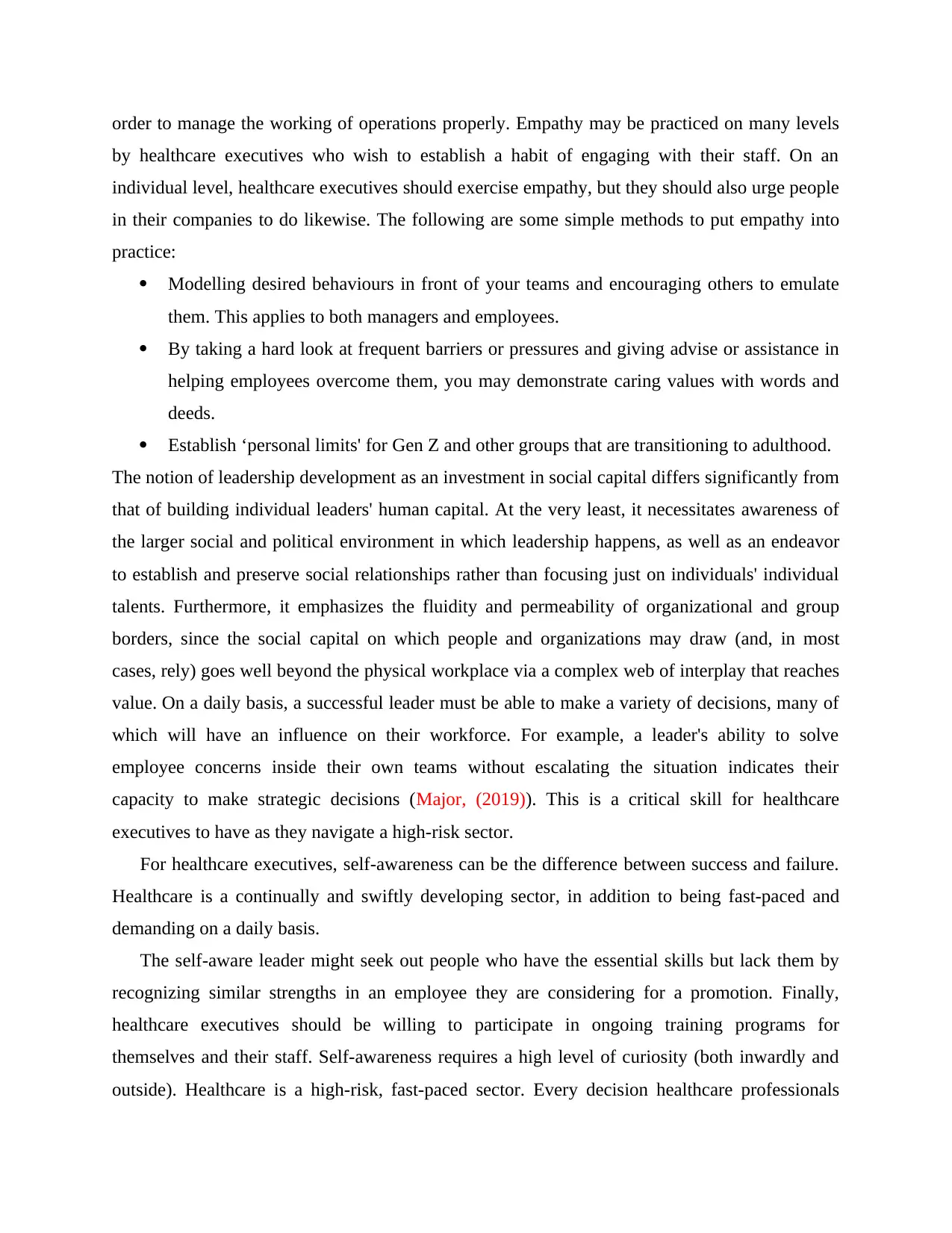
order to manage the working of operations properly. Empathy may be practiced on many levels
by healthcare executives who wish to establish a habit of engaging with their staff. On an
individual level, healthcare executives should exercise empathy, but they should also urge people
in their companies to do likewise. The following are some simple methods to put empathy into
practice:
Modelling desired behaviours in front of your teams and encouraging others to emulate
them. This applies to both managers and employees.
By taking a hard look at frequent barriers or pressures and giving advise or assistance in
helping employees overcome them, you may demonstrate caring values with words and
deeds.
Establish ‘personal limits' for Gen Z and other groups that are transitioning to adulthood.
The notion of leadership development as an investment in social capital differs significantly from
that of building individual leaders' human capital. At the very least, it necessitates awareness of
the larger social and political environment in which leadership happens, as well as an endeavor
to establish and preserve social relationships rather than focusing just on individuals' individual
talents. Furthermore, it emphasizes the fluidity and permeability of organizational and group
borders, since the social capital on which people and organizations may draw (and, in most
cases, rely) goes well beyond the physical workplace via a complex web of interplay that reaches
value. On a daily basis, a successful leader must be able to make a variety of decisions, many of
which will have an influence on their workforce. For example, a leader's ability to solve
employee concerns inside their own teams without escalating the situation indicates their
capacity to make strategic decisions (Major, (2019)). This is a critical skill for healthcare
executives to have as they navigate a high-risk sector.
For healthcare executives, self-awareness can be the difference between success and failure.
Healthcare is a continually and swiftly developing sector, in addition to being fast-paced and
demanding on a daily basis.
The self-aware leader might seek out people who have the essential skills but lack them by
recognizing similar strengths in an employee they are considering for a promotion. Finally,
healthcare executives should be willing to participate in ongoing training programs for
themselves and their staff. Self-awareness requires a high level of curiosity (both inwardly and
outside). Healthcare is a high-risk, fast-paced sector. Every decision healthcare professionals
by healthcare executives who wish to establish a habit of engaging with their staff. On an
individual level, healthcare executives should exercise empathy, but they should also urge people
in their companies to do likewise. The following are some simple methods to put empathy into
practice:
Modelling desired behaviours in front of your teams and encouraging others to emulate
them. This applies to both managers and employees.
By taking a hard look at frequent barriers or pressures and giving advise or assistance in
helping employees overcome them, you may demonstrate caring values with words and
deeds.
Establish ‘personal limits' for Gen Z and other groups that are transitioning to adulthood.
The notion of leadership development as an investment in social capital differs significantly from
that of building individual leaders' human capital. At the very least, it necessitates awareness of
the larger social and political environment in which leadership happens, as well as an endeavor
to establish and preserve social relationships rather than focusing just on individuals' individual
talents. Furthermore, it emphasizes the fluidity and permeability of organizational and group
borders, since the social capital on which people and organizations may draw (and, in most
cases, rely) goes well beyond the physical workplace via a complex web of interplay that reaches
value. On a daily basis, a successful leader must be able to make a variety of decisions, many of
which will have an influence on their workforce. For example, a leader's ability to solve
employee concerns inside their own teams without escalating the situation indicates their
capacity to make strategic decisions (Major, (2019)). This is a critical skill for healthcare
executives to have as they navigate a high-risk sector.
For healthcare executives, self-awareness can be the difference between success and failure.
Healthcare is a continually and swiftly developing sector, in addition to being fast-paced and
demanding on a daily basis.
The self-aware leader might seek out people who have the essential skills but lack them by
recognizing similar strengths in an employee they are considering for a promotion. Finally,
healthcare executives should be willing to participate in ongoing training programs for
themselves and their staff. Self-awareness requires a high level of curiosity (both inwardly and
outside). Healthcare is a high-risk, fast-paced sector. Every decision healthcare professionals
⊘ This is a preview!⊘
Do you want full access?
Subscribe today to unlock all pages.

Trusted by 1+ million students worldwide
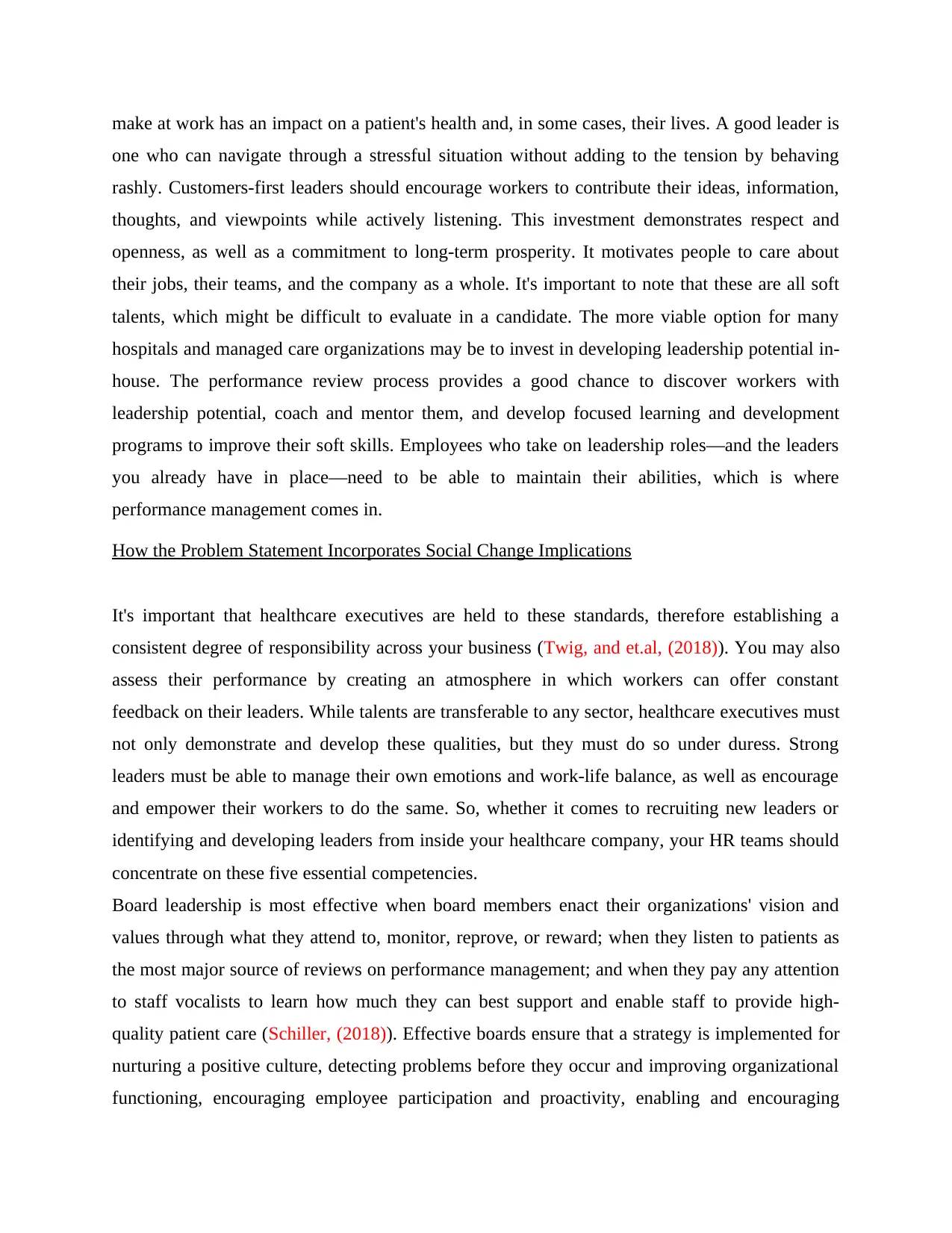
make at work has an impact on a patient's health and, in some cases, their lives. A good leader is
one who can navigate through a stressful situation without adding to the tension by behaving
rashly. Customers-first leaders should encourage workers to contribute their ideas, information,
thoughts, and viewpoints while actively listening. This investment demonstrates respect and
openness, as well as a commitment to long-term prosperity. It motivates people to care about
their jobs, their teams, and the company as a whole. It's important to note that these are all soft
talents, which might be difficult to evaluate in a candidate. The more viable option for many
hospitals and managed care organizations may be to invest in developing leadership potential in-
house. The performance review process provides a good chance to discover workers with
leadership potential, coach and mentor them, and develop focused learning and development
programs to improve their soft skills. Employees who take on leadership roles—and the leaders
you already have in place—need to be able to maintain their abilities, which is where
performance management comes in.
How the Problem Statement Incorporates Social Change Implications
It's important that healthcare executives are held to these standards, therefore establishing a
consistent degree of responsibility across your business (Twig, and et.al, (2018)). You may also
assess their performance by creating an atmosphere in which workers can offer constant
feedback on their leaders. While talents are transferable to any sector, healthcare executives must
not only demonstrate and develop these qualities, but they must do so under duress. Strong
leaders must be able to manage their own emotions and work-life balance, as well as encourage
and empower their workers to do the same. So, whether it comes to recruiting new leaders or
identifying and developing leaders from inside your healthcare company, your HR teams should
concentrate on these five essential competencies.
Board leadership is most effective when board members enact their organizations' vision and
values through what they attend to, monitor, reprove, or reward; when they listen to patients as
the most major source of reviews on performance management; and when they pay any attention
to staff vocalists to learn how much they can best support and enable staff to provide high-
quality patient care (Schiller, (2018)). Effective boards ensure that a strategy is implemented for
nurturing a positive culture, detecting problems before they occur and improving organizational
functioning, encouraging employee participation and proactivity, enabling and encouraging
one who can navigate through a stressful situation without adding to the tension by behaving
rashly. Customers-first leaders should encourage workers to contribute their ideas, information,
thoughts, and viewpoints while actively listening. This investment demonstrates respect and
openness, as well as a commitment to long-term prosperity. It motivates people to care about
their jobs, their teams, and the company as a whole. It's important to note that these are all soft
talents, which might be difficult to evaluate in a candidate. The more viable option for many
hospitals and managed care organizations may be to invest in developing leadership potential in-
house. The performance review process provides a good chance to discover workers with
leadership potential, coach and mentor them, and develop focused learning and development
programs to improve their soft skills. Employees who take on leadership roles—and the leaders
you already have in place—need to be able to maintain their abilities, which is where
performance management comes in.
How the Problem Statement Incorporates Social Change Implications
It's important that healthcare executives are held to these standards, therefore establishing a
consistent degree of responsibility across your business (Twig, and et.al, (2018)). You may also
assess their performance by creating an atmosphere in which workers can offer constant
feedback on their leaders. While talents are transferable to any sector, healthcare executives must
not only demonstrate and develop these qualities, but they must do so under duress. Strong
leaders must be able to manage their own emotions and work-life balance, as well as encourage
and empower their workers to do the same. So, whether it comes to recruiting new leaders or
identifying and developing leaders from inside your healthcare company, your HR teams should
concentrate on these five essential competencies.
Board leadership is most effective when board members enact their organizations' vision and
values through what they attend to, monitor, reprove, or reward; when they listen to patients as
the most major source of reviews on performance management; and when they pay any attention
to staff vocalists to learn how much they can best support and enable staff to provide high-
quality patient care (Schiller, (2018)). Effective boards ensure that a strategy is implemented for
nurturing a positive culture, detecting problems before they occur and improving organizational
functioning, encouraging employee participation and proactivity, enabling and encouraging
Paraphrase This Document
Need a fresh take? Get an instant paraphrase of this document with our AI Paraphraser
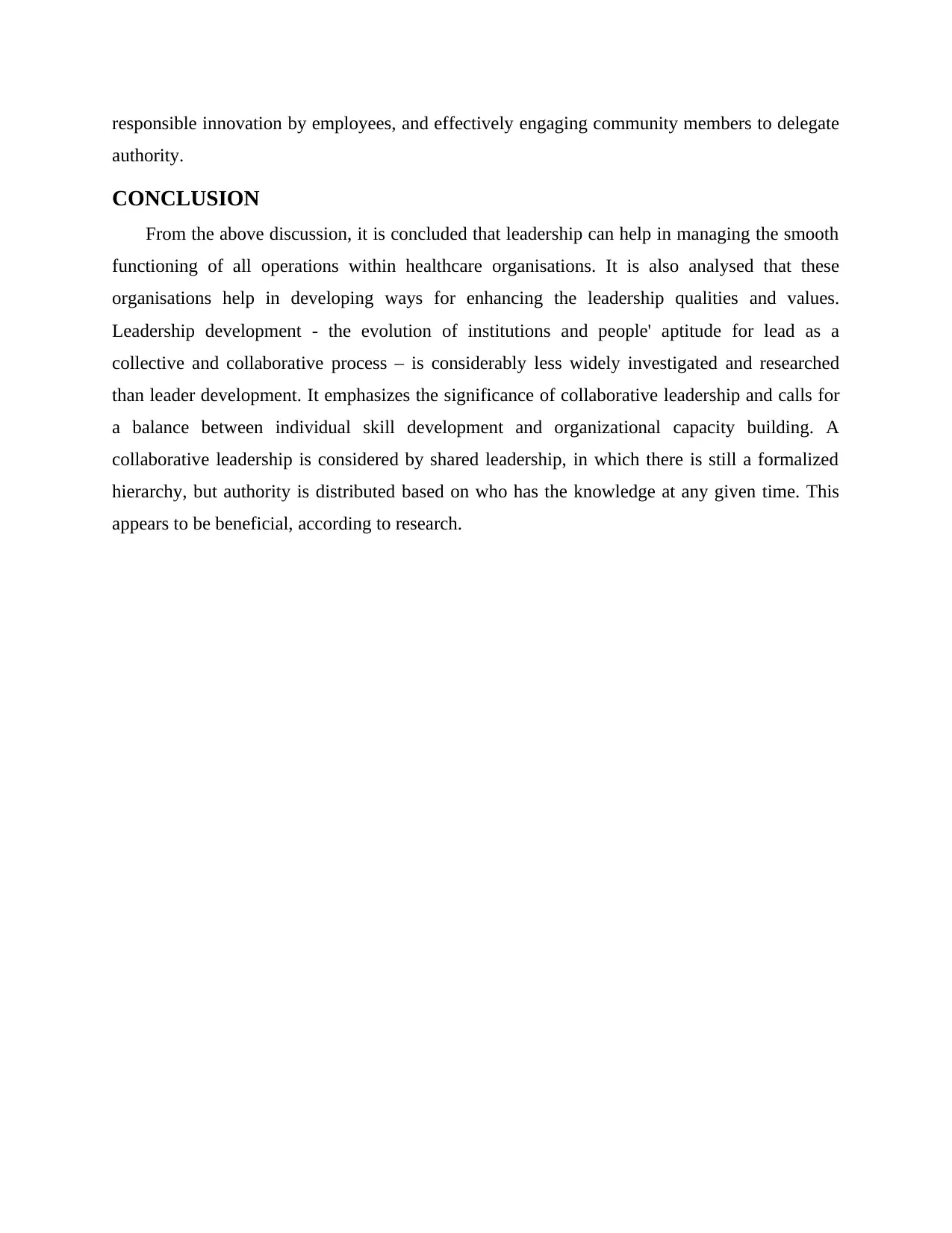
responsible innovation by employees, and effectively engaging community members to delegate
authority.
CONCLUSION
From the above discussion, it is concluded that leadership can help in managing the smooth
functioning of all operations within healthcare organisations. It is also analysed that these
organisations help in developing ways for enhancing the leadership qualities and values.
Leadership development - the evolution of institutions and people' aptitude for lead as a
collective and collaborative process – is considerably less widely investigated and researched
than leader development. It emphasizes the significance of collaborative leadership and calls for
a balance between individual skill development and organizational capacity building. A
collaborative leadership is considered by shared leadership, in which there is still a formalized
hierarchy, but authority is distributed based on who has the knowledge at any given time. This
appears to be beneficial, according to research.
authority.
CONCLUSION
From the above discussion, it is concluded that leadership can help in managing the smooth
functioning of all operations within healthcare organisations. It is also analysed that these
organisations help in developing ways for enhancing the leadership qualities and values.
Leadership development - the evolution of institutions and people' aptitude for lead as a
collective and collaborative process – is considerably less widely investigated and researched
than leader development. It emphasizes the significance of collaborative leadership and calls for
a balance between individual skill development and organizational capacity building. A
collaborative leadership is considered by shared leadership, in which there is still a formalized
hierarchy, but authority is distributed based on who has the knowledge at any given time. This
appears to be beneficial, according to research.
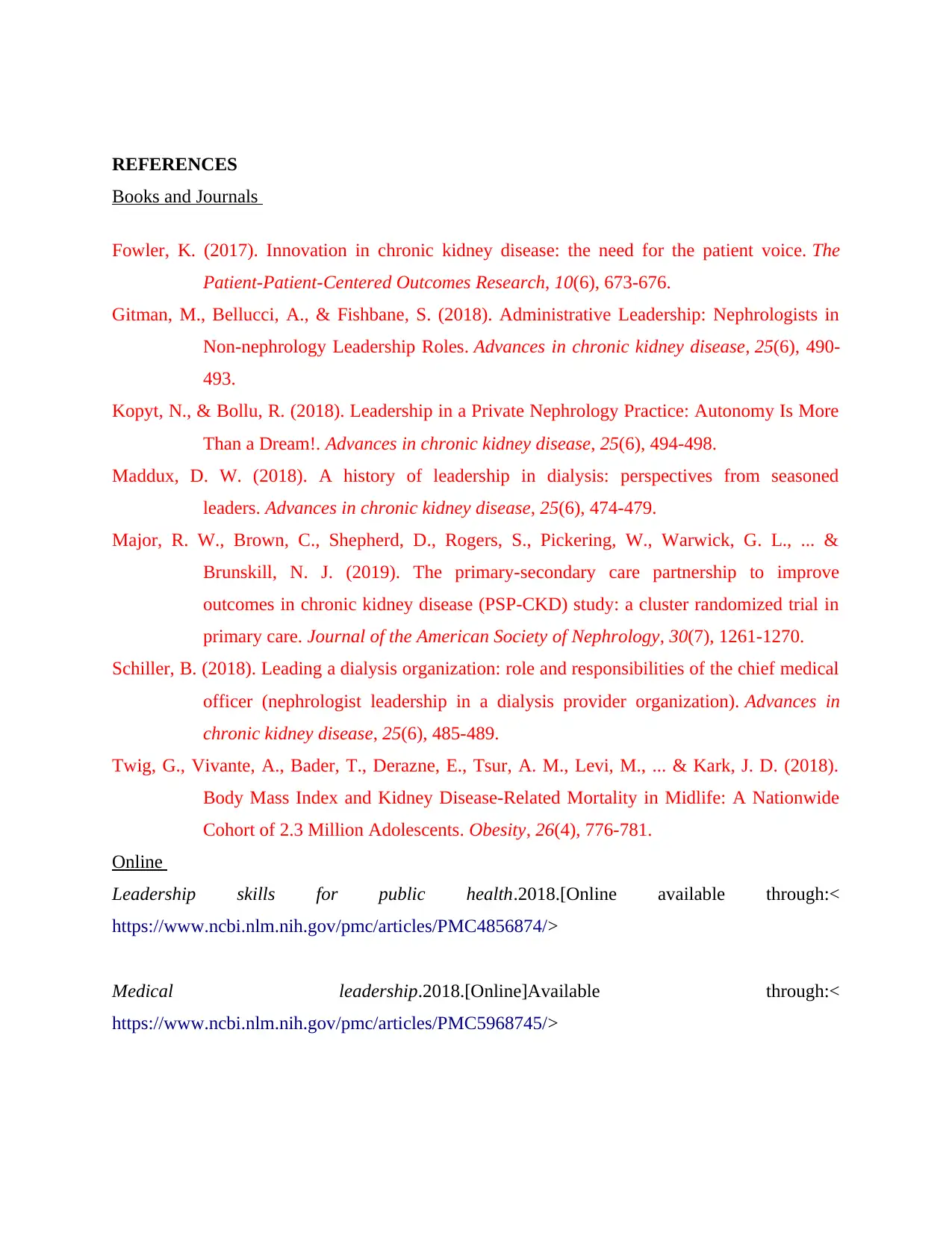
REFERENCES
Books and Journals
Fowler, K. (2017). Innovation in chronic kidney disease: the need for the patient voice. The
Patient-Patient-Centered Outcomes Research, 10(6), 673-676.
Gitman, M., Bellucci, A., & Fishbane, S. (2018). Administrative Leadership: Nephrologists in
Non-nephrology Leadership Roles. Advances in chronic kidney disease, 25(6), 490-
493.
Kopyt, N., & Bollu, R. (2018). Leadership in a Private Nephrology Practice: Autonomy Is More
Than a Dream!. Advances in chronic kidney disease, 25(6), 494-498.
Maddux, D. W. (2018). A history of leadership in dialysis: perspectives from seasoned
leaders. Advances in chronic kidney disease, 25(6), 474-479.
Major, R. W., Brown, C., Shepherd, D., Rogers, S., Pickering, W., Warwick, G. L., ... &
Brunskill, N. J. (2019). The primary-secondary care partnership to improve
outcomes in chronic kidney disease (PSP-CKD) study: a cluster randomized trial in
primary care. Journal of the American Society of Nephrology, 30(7), 1261-1270.
Schiller, B. (2018). Leading a dialysis organization: role and responsibilities of the chief medical
officer (nephrologist leadership in a dialysis provider organization). Advances in
chronic kidney disease, 25(6), 485-489.
Twig, G., Vivante, A., Bader, T., Derazne, E., Tsur, A. M., Levi, M., ... & Kark, J. D. (2018).
Body Mass Index and Kidney Disease‐Related Mortality in Midlife: A Nationwide
Cohort of 2.3 Million Adolescents. Obesity, 26(4), 776-781.
Online
Leadership skills for public health.2018.[Online available through:<
https://www.ncbi.nlm.nih.gov/pmc/articles/PMC4856874/>
Medical leadership.2018.[Online]Available through:<
https://www.ncbi.nlm.nih.gov/pmc/articles/PMC5968745/>
Books and Journals
Fowler, K. (2017). Innovation in chronic kidney disease: the need for the patient voice. The
Patient-Patient-Centered Outcomes Research, 10(6), 673-676.
Gitman, M., Bellucci, A., & Fishbane, S. (2018). Administrative Leadership: Nephrologists in
Non-nephrology Leadership Roles. Advances in chronic kidney disease, 25(6), 490-
493.
Kopyt, N., & Bollu, R. (2018). Leadership in a Private Nephrology Practice: Autonomy Is More
Than a Dream!. Advances in chronic kidney disease, 25(6), 494-498.
Maddux, D. W. (2018). A history of leadership in dialysis: perspectives from seasoned
leaders. Advances in chronic kidney disease, 25(6), 474-479.
Major, R. W., Brown, C., Shepherd, D., Rogers, S., Pickering, W., Warwick, G. L., ... &
Brunskill, N. J. (2019). The primary-secondary care partnership to improve
outcomes in chronic kidney disease (PSP-CKD) study: a cluster randomized trial in
primary care. Journal of the American Society of Nephrology, 30(7), 1261-1270.
Schiller, B. (2018). Leading a dialysis organization: role and responsibilities of the chief medical
officer (nephrologist leadership in a dialysis provider organization). Advances in
chronic kidney disease, 25(6), 485-489.
Twig, G., Vivante, A., Bader, T., Derazne, E., Tsur, A. M., Levi, M., ... & Kark, J. D. (2018).
Body Mass Index and Kidney Disease‐Related Mortality in Midlife: A Nationwide
Cohort of 2.3 Million Adolescents. Obesity, 26(4), 776-781.
Online
Leadership skills for public health.2018.[Online available through:<
https://www.ncbi.nlm.nih.gov/pmc/articles/PMC4856874/>
Medical leadership.2018.[Online]Available through:<
https://www.ncbi.nlm.nih.gov/pmc/articles/PMC5968745/>
⊘ This is a preview!⊘
Do you want full access?
Subscribe today to unlock all pages.

Trusted by 1+ million students worldwide
1 out of 14
Related Documents
Your All-in-One AI-Powered Toolkit for Academic Success.
+13062052269
info@desklib.com
Available 24*7 on WhatsApp / Email
![[object Object]](/_next/static/media/star-bottom.7253800d.svg)
Unlock your academic potential
Copyright © 2020–2025 A2Z Services. All Rights Reserved. Developed and managed by ZUCOL.





